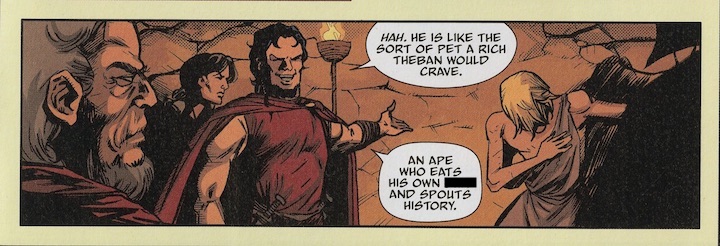
July 15, 2020, by Lynn Fotheringham
Plataea
(Διαβάστε στα ελληνικά.) (Revised 24/08/20.)
CONTENT: ANCIENT GREEK SLAVERY, MILITARY ACTION, VIOLENCE, DEATH, IMAGES OF VIOLENCE
Three, by Kieron Gillen & Ryan Kelly; chapter/issue 1, cont. [For an introduction to Three, see this post.
Following Terpander’s comments on Thermopylae, Arimnestos questions his knowledge of history, and Terpander notes that the young Spartiate is the namesake of a man who ‘wasn’t with the 300, but he avenged them.’ He is referring to the battle of Plataea, a year after Thermopylae, where the Persian army was finally defeated by the Greeks. The eve of this battle is the setting for the final pages of Frank Miller & Lynn Varley’s 300. Terpander introduces the story like this:

THREE, ch.1, p.21 panel 1
A shift in visual style then introduces a story-within-a-story depicting the battle, in which the most important point is that Arimnestos’ namesake is identified as having killed the Persian generalissimo, Mardonios:

THREE, ch.1, p.21 panel 2-5
Mardonios’ killer is identified in two ancient sources. Herodotus 9.64.2 gives his name as Aeimnestos:
ἀποθνήσκει δὲ Μαρδόνιος ὑπὸ Ἀειμνήστου ἀνδρὸς ἐν Σπάρτῃ λογίμου, ὃς χρόνῳ ὕστερον μετὰ τὰ Μηδικὰ ἔχων ἄνδρας τριηκοσίους συνέβαλε ἐν Στενυκλήρῳ πολέμου ἐόντος Μεσσηνίοισι πᾶσι, καὶ αὐτός τε ἀπέθανε καὶ οἱ τριηκόσιοι. |
As for Mardonius,* he was slain by Aeimnestus, a Spartan of note; who long after the Persian business did in time of war lead three hundred men to battle at Stenyclerus against the whole army of Messenia, and was there slain, he and his three hundred. |
- Text and translation by A.D. Godley, Loeb Classical Library vol. 120, 1925.
Plutarch, Aristides 19.1, gives his name as Arimnestos:
καὶ τὸν Μαρδόνιον ἀνὴρ Σπαρτιάτης ὄνομα Ἀρίμνηστος ἀποκτίννυσι, λίθῳ τὴν κεφαλὴν πατάξας, ὥσπερ αὐτῷ προεσήμανε τὸ ἐν Ἀμφιάρεω μαντεῖον. |
Mardonius was slain by a man of Sparta named Arimnestus, who crushed his head with a stone, even as was foretold him [= Mardonius] by the oracle in the shrine of Amphiaraüs. |
- Text and translation by Bernadotte Perrin, Loeb Classical Library vol.47, 1914.
The variation in the killer’s name is not particularly worrying; there are five centuries between Herodotus and Plutarch, plenty of time for such a detail to be misremembered.
The detail from Plutarch about Arimnestos crushing Mardonios’ head with a stone has been dropped in the comic; I’ll come back to that in the next post. Plutarch follows this comment with some cute details about Mardonios’ interaction with the oracle. Herodotus loves a good oracle story as much as Plutarch does, but doesn’t mention this one; it doesn’t add all that much to narrative, in my view, and it may be the sort of embellishment that creeps in over time. (Any Plutarch-experts have an opinion?)
The fictional Arimnestos of a century later responds quite well to Terpander’s account of Plataea:

THREE, ch.1, p.21 panel 6
But Terpander can still snatch defeat from the jaws of victory… If you’ve read the comic, you may remember what he’ll use to do this; if not, it is already visible in what I’ve included in the current post. Can you spot it? Go to the next post to check!
* I use ‘Mardonios’ when talking about the comic because that’s the form Kieron uses; but I use ‘Mardonius’ when quoting these translations because that’s the form the translators use. The variety is due to the fact that the letters of the Greek alphabet can be transliterated into Latin letters (the ones we use in English) in a variety of different ways. (The situation is further complicated by dialect variations within the spelling of ancient Greek itself…) If anyone would like me to post a general comment on the variations in Greek spelling, let me know!
NOTE: I may refer to/quote comments on this post either in later blog-posts or in a research publication. More information about my audience-research, including a Privacy Notice and ways of getting hold of the book.
Extracts from Three © 2013 Kieron Gillen & Ryan Kelly. Used with permission.
No comments yet, fill out a comment to be the first

Leave a Reply